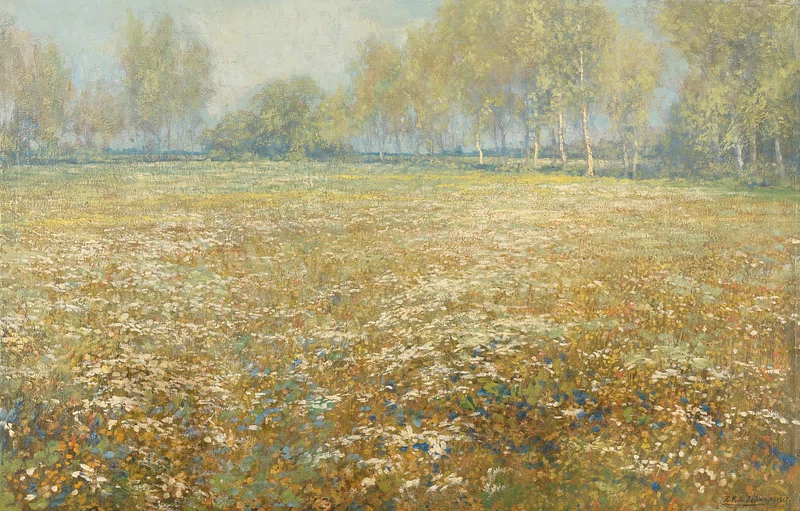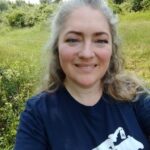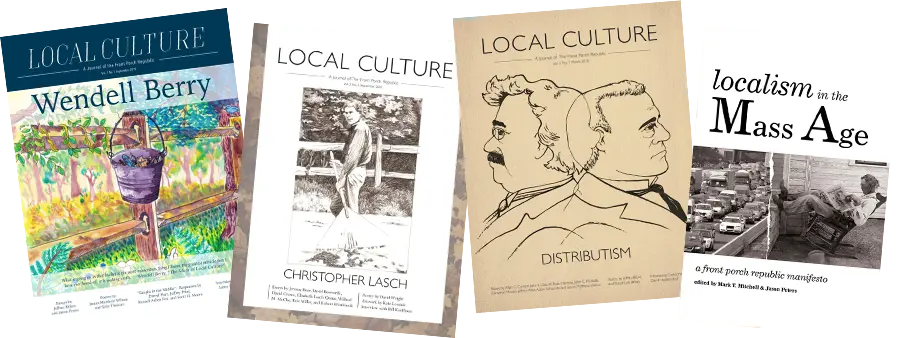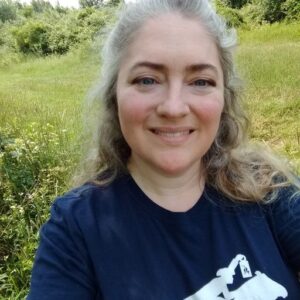A particularly fine August weekend enticed my husband and me to travel northward to Sleeping Bear Dunes National Lakeshore. We didn’t go to climb the dunes but to visit the Port Oneida Rural Historic District. Within its boundaries the park is at work preserving a smattering of homesteads—houses, barns, a schoolhouse, and even an orchard—to recreate this small community as it was before it faded away under the onslaught of economic forces, agricultural challenges, and the eventual transition of the area into one devoted more to tourism than to agrarian life.
What drew us this particular weekend was the annual Fair. If you have ever attended one of these sorts of events, you’ll be familiar with the demonstrators showing park guests how various homestead tasks were performed, modeling what tools were used, and sometimes even allowing them to try their hand. A horsedrawn wagon carried visitors from one homestead to the next in proper period style.
On arrival we were greeted and presented with a small map and a precis of the goings-on. The volunteer, a member of the local historical society, asked if we had ever visited before. I smiled and told her that I had—my great-great-great-grandfather is buried there, in the cemetery next to one of the farm houses. Her face softened and she moved immediately from “teacher” mode to a reverent attitude. My blood and bone had built this place that she was acting as a hostess for. She indicated the pickup point for the wagon that went on to the Kelderhouse farm.
Kelderhouse Cemetery is a bit of a grandiose moniker for worn stones peeking out among the long grass. A fence keeps users of the adjacent bike trail from causing accidental damage, but it’s just a simple country graveyard, a stone’s throw from the house and orchard next to it. John Van Wormer’s stone is small, but the carved words are still clear. Next to it, someone had tucked a spray of silk flowers.
Tourists taking turns at churning butter and painting barn quilt squares chat with volunteer costumed presenters, oblivious to the quiet bones of the place that underlie it all. The Kelderhouse farmhouse is closed to visitors and so ignored by them. But once it was the beating heart of the small community. By turns grocery store, telephone headquarters, and post office, it stood as an anchor between the schoolhouse and the Lutheran church.
The farmhouse stood just beyond the action of the Fair, and we headed that way, walking past a few displays, including a demonstration of timber-frame construction. It’s a technique that has fallen out of fashion, but one that creates a house that genuinely has the “good bones” so loved by renovation gurus.
This is the pattern of rural settlement: A small cluster of buildings that met most of the needs of the community, intimately associated with some of its leaders. Round about sat other farms, becoming more isolated the further their distance from the center. No village green marks the spot, nor a main street now converted into boutiques and art galleries. The bones of Port Oneida are harder to see, but still present, like timbers with tightly fitted joints still unbowed by time.
It’s a far cry from the suburbia that spills out around nearby Traverse City, and most other even mildly urban centers. Zoning boards keep suburban residents separated. Houses roll away over hill and dale sprawling like wood-and-brick groundcover, flanked by pockets of strip malls, churches, and anything else dubbed “commercial.” They are shaped more by access to highways and major roadways than by a need to gather together. Like prefabricated walls tacked together at the corners, cracks are beginning to show in the drywall and sagging in the joists as social, economic, and environmental cohesion begins to fail.
To take note of older settlements like Port Oneida, with their more walkable centers, mutual dependence of neighbors, and surrounding supporting land is not only an exercise in nostalgia. It’s a search for what used to work. But attempts to recreate them by planning for little pockets with a few shops inside a subdivision or sidewalks that link green spaces is a bit like propping up a sagging floor with a single post in the basement. It can’t begin to replace that robust, interlocking frame.
Timber frames and cross-braced communities both resist attempts to design and install them at scale by national building companies employing hordes of “fast framers” and sold by marketing companies with glossy brochures.
Timber frames and cross-braced communities both resist attempts to design and install them at scale by national building companies employing hordes of “fast framers” and sold by marketing companies with glossy brochures. But lap joints with handmade pegs and intergenerational local relationships and institutions are custom-made, human-scale construction.
When cared for and maintained, both last decade upon decade and begin to mark time in centuries. Abandoned, even they will eventually succumb to the effects of time and neglect, as communities disintegrate and beams begin to bow—like the slowly collapsing barns that dot the countryside, carcasses gradually picked clean for reuse as “barnwood” feature walls and “reclaimed” mantle pieces. What happened?
The lure of efficiency, whether as industrialized agriculture, cheap energy, and standardized zoning laws undermined the foundations. Many of these communities were hollowed out as small-scale farming became untenable and younger generations were encouraged to seek “success” doing something—anything—else, in the fast lane of modern culture. Placelessness was integral to upward mobility, suburban houses, and fashionable friend groups—all rewards that hung like the brass ring, ready for the taking.
Placelessness was integral to upward mobility, suburban houses, and fashionable friend groups—all rewards that hung like the brass ring, ready for the taking.
These bright new communities, with their bright young residents, have ended up seeming hollow, populated as they are with people who feel uprooted and a little homeless. Some of them have begun to listen to the homestead movement or the localists or the agrarians and are determined to try to return to those older communities.
Like those who inherit a mansion, sometimes they turn up to find holes in the ceilings, missing floorboards, and broken-out windows. Those with a discerning eye, however, can see the good bones, if only the frame can be strengthened and the house made safe and warm again. The goal isn’t to restore every corner to its former glory, but to embrace the history while making it a solid and welcoming home for the people who live in it now—modern plumbing included.
But no such restoration project can take place by using a suburban house plan or prefab elements. Old communities are unique and require a respectful approach to rebuilding.
“One size fits all” must be discarded, along with the goal of growth for growth’s sake. At the same time, vivification of places as breathing communities is not the same as creating a Historic Village populated with costumed reenactors. Suburban zoning laws are not adequate to address places that are meant to be knitted communities. The Kelderhouses surely would have run afoul of a dozen such regulations in the years their house served as a store, or the post office, or a number of other functions.
Agricultural preservation programs designed to shield agribusiness practices are inadequate to the task of safeguarding true rural community. Tailored land trusts, deeded allotment systems, and modified zoning categories are all tools that can be used to set up bulwarks against the rising tide of rampant overdevelopment that destroys rural spaces.
In genuine communities, the household economy must be embraced and supported. Real families support themselves with things like a sugar shack, to make maple syrup, or an honor stand selling cut flowers. “Commercial” and “residential” don’t have to be confined to entirely separate districts. Clusters of homes, small businesses, churches, and other local entities can thrive in the midst of the land-based activities that support them: small market farms, U-pick orchards, berry patches, and cottage dairies, to name a few. They serve as the cedar shingles and clapboard that keep the frame dry and solid. Under such a shelter nestle pantry, hearth, and snug bedrooms that cultivate a rich local food culture, economic resilience, and generational rootedness.
Every field lost to a suburban-style development or strip mall and parking lot amounts to a hole in the roof or a broken windowpane. And, bit by bit, it becomes unlivable. Once the home stops sheltering people, its degradation has begun.
Standing in the lawn in front of the Kelderhouse farm, overlooking the cemetery, I stood amongst bones bleached dry and white. Within the bounds of the National Park, there is no way to restore that old community. It now sits under glass, like a diorama of a real place. It was built by people who meant it to last, leaning on each other to create a place that would nurture their children and grandchildren. But the allure of easier living and bright fortunes in places with better ground or deeper harbors pulled away those children, and then grandchildren. I lost an inheritance that might have been, not just of land but of the shelter of a community, even the distant cousin who might have left those silk flowers. Likewise, the descendants of the other people who rest in this tiny graveyard lack knowledge of each other and the wisdom that comes from living with regard to each other and the land.
The house is empty and locked to protect it from vandals. The same is true of the schoolhouse across the street. The old church is gone entirely. Fields once filled with golden grain and green hay are given over to native wildflowers that wave in the sun. Like a skeleton carefully mounted in a museum, we can see the bones of what this place was. It’s given over to “preservation,” sterile and unable to breathe again. No vision of Ezekiel stirs here.
In other places like Port Oneida, though, there are still good bones to be restored. All it will take is the will to inhabit them again, and the courage to reject the mantras of growth and efficiency that have come to govern the spread of “sameness” that is part of the ever-darkening current “American Dream.” The will to replace it with something brighter, softer, more deeply rooted, a life that carries with it the scent of hay fields after the rain.
Image Credit: Egbert Rubertus Derk Schaap, “Meadow in Bloom” (1913) via Rawpixel.







